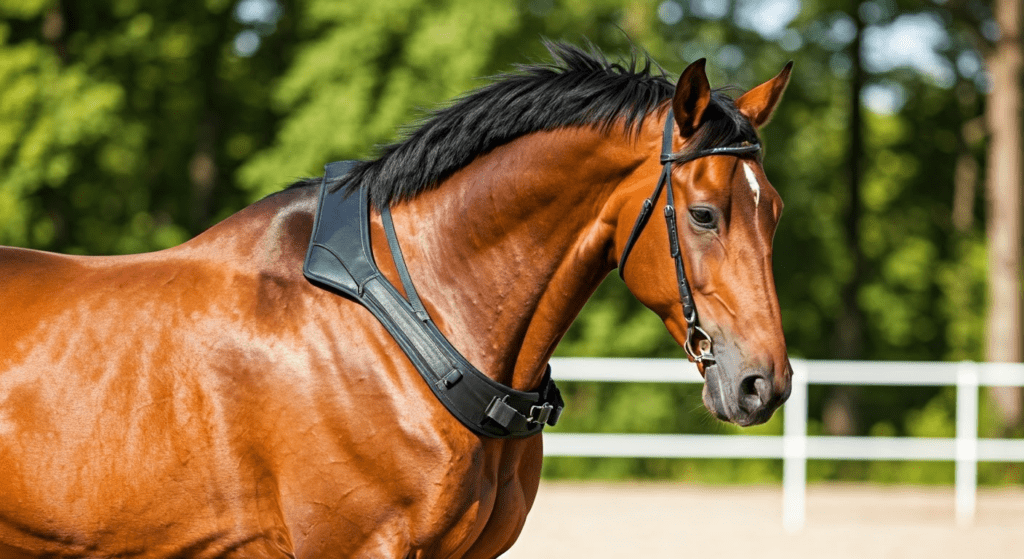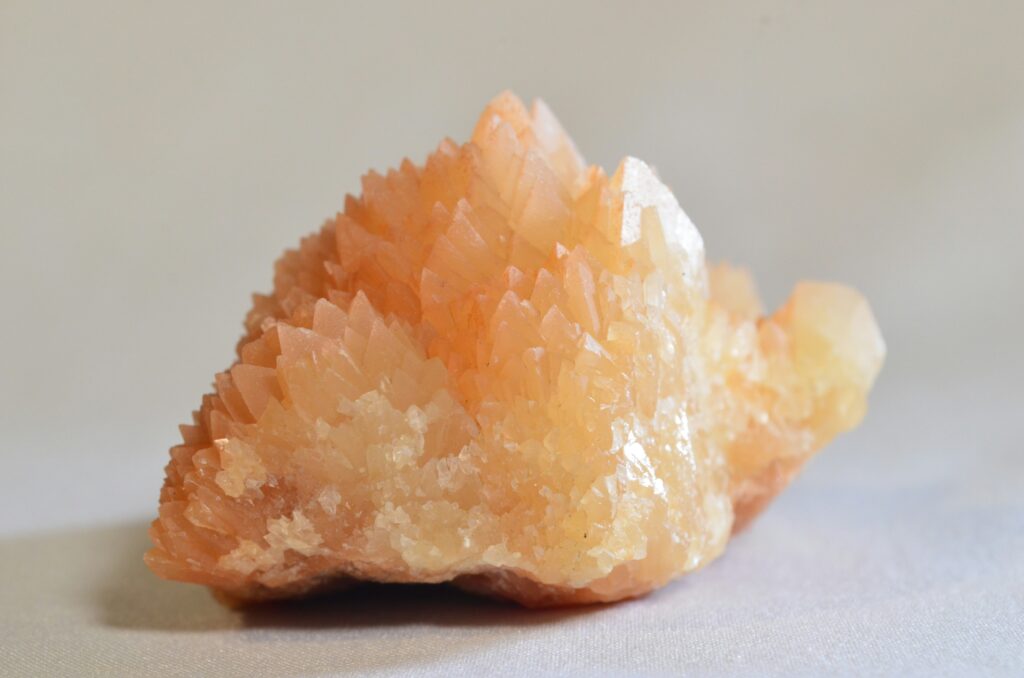Key Highlights
- A well-fitted breastplate enhances your horse’s comfort and performance while riding.
- It prevents saddle slippage, offering stability during jumps or challenging terrains.
- Different types of breastplates exist, each fulfilling specific needs.
- Proper adjustment is vital; a poorly fitted one can hinder movement and cause discomfort.
- Regular cleaning and inspection ensure the breastplate’s longevity and optimal function.
Introduction
In horse riding, it is very important to keep your horse comfortable and happy. One key piece of gear is the breastplate. It helps keep the saddle secure and stable. With the breastplate holding the saddle in place, riders can feel calm. This lets them pay attention to their riding skills and enjoy time with their horse.
Ensuring Your Horse’s Comfort and Performance: Selecting the Right Breastplate
Just like riding hats or saddles, breastplates and bridles come in different sizes. It is important to pick the right breastplate for your horse. This choice depends on several things, such as the type of riding you do, the shape of your horse, and what you prefer.
If you enjoy calm trail rides, fast jumping, or graceful dressage, it is important to know the different kinds of breastplates and how to use them. This knowledge helps you choose the best fit for your horse.
The Importance of a Well-Fitting Breastplate
A good horse breastplate is very important for how a horse performs and feels while riding. A breastplate that fits well keeps the saddle from moving around. This is especially important during jumping or when riding on rough ground.
When the saddle stays in place, it helps the horse feel comfortable. It does this by preventing pressure and rubbing on their skin. This stable fit also allows the horse to move freely, which improves their performance. In addition, a secure saddle helps keep the rider safe, giving them a stable place to sit.
So, when you choose a breastplate, make sure it fits well. This will make riding more enjoyable and safer for both the horse and the rider.
Key Features of a High-Quality Horse Breastplate
When you buy a horse breastplate, you should think about quality, comfort, and how long it will last. Good breastplates usually have padding in the right spots and come in various colour options. For example, the chest strap might use soft fleece to stop pressure and keep the horse from rubbing against it.
Adjustable straps made of strong nylon or tough leather are important too. They help create a fit that is secure and just right for your horse, especially when considering options with free shipping. Trustworthy brands, like Zilco, are known to have strong parts, like solid D-rings and buckles. This helps the breastplate last through many rides.
Choosing a breastplate with these good features will help your horse feel comfortable and your gear last a long time.
Understanding Different Types of Breastplates and Their Uses
Selecting the right type of breastplate is crucial depending on your riding discipline and your horse’s needs.
| Type of Breastplate | Description |
| Hunting Breastplate | Features a neck strap for added stability, ideal for riding over fences. |
| 5-Point Breastplate | Offers maximum saddle stability with multiple attachment points, suitable for jumping. |
| 3-Point Breastplate | A versatile option that attaches at three points, suitable for various disciplines. |
| Point Breastplate | Simple design attaching at the saddle’s point, suited for flatwork and light riding. |
| Breastplate with Martingale Attachment | Combines a breastplate with a running martingale for additional head control. |
Choosing the correct type ensures your horse’s comfort and promotes optimal performance for different equestrian activities.
How to Properly Adjust and Fit a Breastplate
A properly fitting breastplate is very important for your horse’s comfort and performance while riding. When you fit it, make sure all the straps are tight enough to hold it in place but still let your horse move freely. The breastplate should be flat against the horse’s body. The chest strap needs to be placed below the windpipe.
Always look for signs of rubbing or discomfort. These can show that it does not fit right. A well-fitted breastplate helps to create a happy and safe riding experience for your horse.
Maintaining Your Breastplate for Longevity and Performance
Keeping your horse’s breastplate in good shape is important for its long life and good performance. Always clean it after each ride. This helps keep the materials in good condition.
To clean it, use a damp sponge to wipe off sweat and dirt. Then, let it air dry. It’s also important to check the breastplate for any damage, like broken stitching or cracked leather. This allows you to spot problems early, which helps keep it safe and working well.
Taking care of it regularly will make it last longer and help it perform at its best during every ride.
Practical Tips for Fitting a Horse Breastplate
Properly fitting a horse breastplate is important for your horse’s comfort and for it to work well. Start by knowing the different parts of the breastplate and what each part does.
Begin with the breastplate loosely fitted. Then, slowly adjust the straps for a snug fit that doesn’t restrict your horse. A good-fitting breastplate is key for your horse’s health and your calmness while riding.
Measuring Your Horse for the Perfect Fit
Before buying a breastplate, you need to measure your horse to get the right fit. A breastplate that doesn’t fit well can make your horse uncomfortable and affect how it performs. It could even cause injuries.
Start by measuring from the girth groove to the middle of the chest. This is where the breastplate will lie. Then, measure from the D-ring on one side of the saddle to the D-ring on the other side. This will help you ensure a good fit around your horse’s chest.
Getting accurate measurements is important when you choose the best size breastplate for your horse.
Adjusting the Breastplate for Optimal Comfort and Safety
Once you have the right size breastplate, make sure to adjust it for comfort and safety before you ride. First, attach the breastplate to the D-rings on the saddle. It should sit snugly on your horse’s chest.
Next, adjust the chest strap. You should be able to fit two fingers comfortably between the strap and your horse. Also, check the wither strap, if you have one. It should not press on your horse’s windpipe.
When you adjust it properly, the breastplate will fit well. This will help keep your horse comfortable and avoid any trouble with breathing while riding.
Checking the Position of the Chest Strap
The chest strap position is important for your horse’s comfort. It should rest flat against the chest and be about a hand width behind the horse’s elbows when the horse is standing.
Make sure the chest strap is not too high. If it is, it may block the horse’s airway and lead to breathing trouble. On the other hand, if the strap is too low, it can get in the way of the horse’s elbows, making it hard for them to move.
Check the position of the chest strap often and adjust it when needed. This is especially important as your horse’s fitness or body shape changes.
Ensuring the D-rings Are Properly Positioned
The D-rings on a breastplate are very important for how it works. They are usually attached to the saddle’s D-rings. It’s important to place them so there is a straight pull from the saddle to the breastplate.
This setup helps spread the pressure evenly. It stops the breastplate from pulling or rubbing against the horse’s shoulders or chest in a bad way.
So, always check that the D-rings on your breastplate are set up right. This will help make sure it is comfortable and works well.
Regular Maintenance and Inspection for Durability
It is important to make sure your horse’s breastplate fits well. You should also check it regularly for any signs of wear and tear. Look closely at the straps for fraying, cracking, or stretching that might affect their strength.
Don’t forget to check the buckles and D-rings too. They should be free from rust or damage. These parts help keep the breastplate secure. If you notice any wear or damage, fix or replace the parts right away. Taking care of this ensures the breastplate lasts longer and keeps your horse safe from discomfort or injuries caused by faulty equipment.
Conclusion
Investing in a good horse breastplate is very important for your horse’s comfort and performance. By choosing the right breastplate, knowing its features, adjusting it correctly, and taking care of it, you can make sure it lasts a long time and works well. Make sure to measure your horse properly. Adjust it for comfort and safety, and check it regularly. Focusing on these steps will help your horse feel better and improve its performance and lifespan. Use these simple tips to ensure your horse’s comfort and get the most out of its abilities.
Frequently Asked Questions
How often should I check the fit of my horse’s breastplate?
It’s a good idea to check how well your horse’s breastplate fits before every ride. This will help keep your horse comfortable. It also lets you make changes when needed, like if your horse gets fitter or changes shape.
What is the purpose of a horse breastplate?
A horse breastplate is a key part of riding gear, along with ear bonnets. It keeps the saddle in place. This helps stop the saddle from sliding back, especially when jumping. It makes sure both the horse and rider are safe and comfortable.
Are there different types of horse breastplates available, and how do I choose the right one for my horse?
Yes, there are different types of breastplates designed for various riding styles and what horses need. When picking the right breastplate for your horse, you should consider the type of riding you do, your horse’s shape, and what you prefer.


